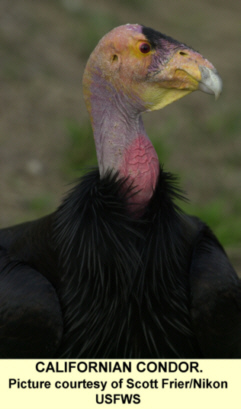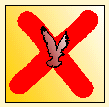
CALIFORNIA CONDOR.
Gymnogyps califonianus.
IDENTIFICATION. Both male and female California Condors have bare yellow-orange heads and neck. The body plumage is black with some brown edging on the back feathers. Each wing has a white triangle patch that extends from the body, as well as a white bar on the upper wing surface. The legs are pink and the beak is a light grey/white.
Immature birds can be identified by their dark head and neck that is covered with grey down. Adult plumage is obtained at 5 to 6 years of age.
Can be mistaken for the Andean Condor or Turkey Vulture.
IN FLIGHT. The California Condor relies on soaring flights to find food. Roosting on high vantage points it takes to the air with very few wing beats. Using its huge 9 foot wingspan to find warm thermal updrafts, it circles high into the sky with little effort.
DISTRIBUTION. North America, including California and British Columbia. Preferring open savannah and hilly country with rock outcrops and trees for nesting and roosting.
WHEN SEEN. All year round.
FOOD. Carrion.
BREEDING. February-May. 1 egg laid on the ground on a rock ledge or slope. The egg is incubated for 59 days. Flying may take up to 7 months with the immature becoming independent from the parents a year later.
SIZE. 109-140 cm (43-55 inches)
WINGSPAN. 259-290 cm (102-114 inches)
WEIGHT. 8-14 kg (18-31lbs)
CALL. Having no voice box the California Condor communicates with growls, hisses, grunts and body language.
FALCONRY.
Not generally used in Falconry.
Falconry
marks
